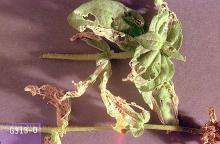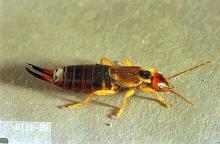Primarily European earwig (Forficula auricularia)
Pest description and damage This introduced, nocturnal insect can devastate seedlings, flowers, leaves and fruit. Adults are brown in color and roughly 0.5 inch long. Easily recognized by the hind pinchers, called cerci, they are reviled by gardeners. The adults are winged, but the hind wings are folded under the short and stubby fore wings. Immature earwigs resemble adults but are smaller, lack wings and may be paler in color. While despised by homeowners, earwigs also can be beneficial by feeding on aphids and other small insects. They also scavenge dead bugs, plant debris, and feed on live plant tissue. Earwigs chew irregular, variable-sized holes in leaves. Earwigs are often worse in dry eastern climates or in dry years.
Biology and life cycle Females carefully tend clusters of up to thirty eggs, in small nests under rocks in the soil in winter. They clean fungi from the eggs and protect their eggs and young. In spring, the earwig "family" feeds together, but as the young mature, they go their separate ways. There is one generation a year. Earwigs are nocturnal. During the day, they seek moist, dark places, under stones, debris and even in flower heads and damaged fruit.
Pest monitoring Search with flashlight at night. Earwigs are omnivorous and easily attracted to fish oils and cat food in traps. Vigorously shake flowers over a box lid to knock earwigs off plants.
Management-cultural control
Remove debris and hiding places in gardens. Commercial earwig traps are available.
Management-biological control
Frogs, toads, predator beetles and duff-scratching birds are common predators. Fungi may attack eggs in winter nests.
Management-chemical control:
See Table 2 in:
Chemical Control of Landscape Pests
For more information
Flint, M.L and B. Ohlendorf. 2002. Earwigs. UC ANR Publication 74102 (http://www.ipm.ucdavis.edu/PMG/PESTNOTES/pn74102.html)






